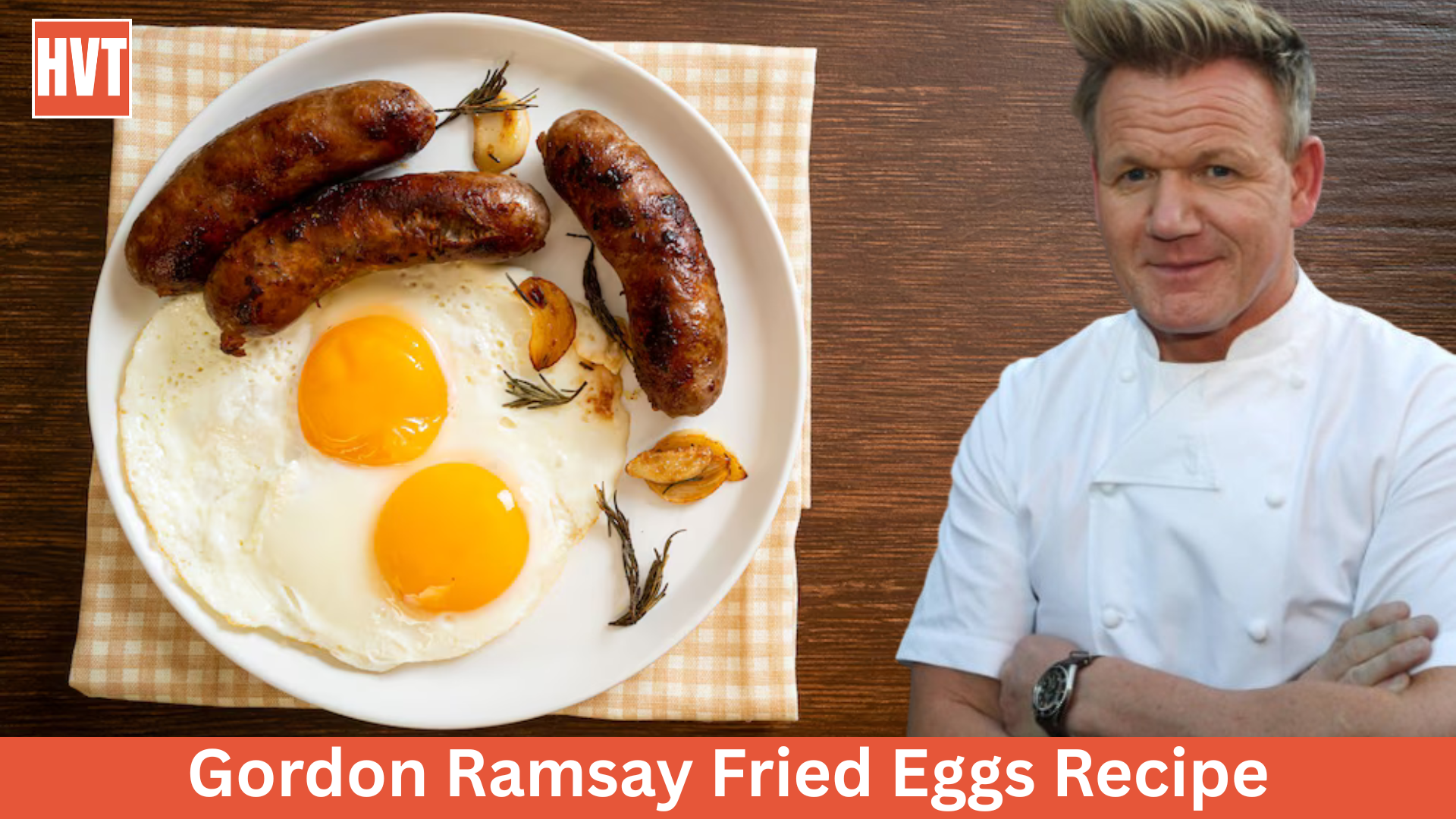
You’ve Been Frying Eggs Wrong – Gordon Ramsay Fried Eggs Hack Is a Game Changer
Picture this: You’re standing over the stove, spatula in hand, poking at a sad, rubbery egg. The yolk’s overcooked, the edges are burnt, and you’re wondering why breakfast feels like a chore. Sound familiar? Here’s the truth—you’re not alone. Even home cooks think they’ve mastered fried eggs… until they try Gordon Ramsay’s method.
The Michelin-starred chef’s 5-minute fix isn’t about fancy gear or chef secrets. It’s about unlearning bad habits (high heat, impatience) and embracing butter-basted magic. Spoiler: Your mornings just got a crispy-edged, silky-yolked upgrade.

Also See: Top 10 Gordon Ramsay Eggs Recipe
What Makes Gordon Ramsay’s Fried Eggs Different?
Think of your usual fried egg: unevenly cooked whites, a yolk that’s either lava or chalk. Ramsay flips the script. Instead of cranking the heat, he coaxes the eggs to perfection with low-and-slow cooking. It’s like swapping a sprint for a mindful stroll. His secret weapon?
Butter basting—spooning golden, foamy butter over the yolks, infusing richness while gently setting the whites. Then, the swirl-and-tilt trick: a wrist flick that spreads the egg thin for crispy lace edges. No chef’s hat needed—just science, patience, and a little kitchen swagger.
Ingredients You’ll Need for Chef-Level Fried Eggs
Let’s cut through the noise—no exotic pantry items here. Ramsay’s genius lies in doing more with less.
The Essentials
- Fresh eggs (room temp): Cold eggs = uneven cooking. Let them lounge on the counter first.
- Unsalted butter: Skip the oil. Butter’s richness is non-negotiable for flavor and crispness.
- Salt & pepper: Finish after cooking to avoid toughening the whites.
Optional Upgrades
- Chili flakes (for heat), fresh herbs (thyme or chives), or a Parmesan sprinkle.
Why These Ingredients Work
Butter’s milk solids caramelize for crispy edges, while fresh eggs guarantee velvety yolks. Ramsay’s mantra: Elevate, don’t complicate.
Step-by-Step: Gordon Ramsay’s Fried Egg Masterclass
Don’t panic—this isn’t a cooking exam. Ramsay’s method is foolproof if you follow these simple, no-stress steps:
Step 1: Heat the Pan Like a Pro
- Grab a non-stick skillet (or well-seasoned cast iron).
- Set it over low-medium heat—no jet-engine flames here.
- Add 1 tbsp unsalted butter. Let it melt until foamy, not brown. (Burnt butter = bitter eggs.)
Step 2: Crack, Swirl, and Relax
- Crack eggs into a small bowl first (prevents shell surprises).
- Gently slide them into the pan. Now, tilt and swirl the pan so the whites spread thin. Thinner whites = lacy, crispy edges.
Step 3: Butter Basting 101
- Tilt the pan slightly. Use a spoon to scoop the foamy butter and drizzle it over the yolks—like giving them a golden shower. Do this 6-8 times. This gently cooks the tops without flipping.
Step 4: Know When to Quit
- Wait until edges turn golden-crisp and whites are just set (about 2-3 minutes). The yolks should still jiggle—they’ll firm up off-heat.
- Slide onto a plate. Immediately season with salt, pepper, or chili flakes.
Pro Tip: Room-temp eggs cook evenly. If yours are fridge-cold, soak them in warm water for 5 minutes pre-crack.
That’s it. No fancy spatula gymnastics. No stress. Just butter, patience, and a trusty spoon. Your reward? Eggs so good, you’ll side-eye diner brunch forever.
Also See: Gordon Ramsay Deviled Eggs Recipe
3 Common Mistakes (And How Ramsay Avoids Them)
We’ve all been there—these blunders turn dreamy eggs into breakfast nightmares. Here’s how Ramsay sidesteps them:
High Heat = Rubbery Chaos
- The Mistake: Cranking the burner to “inferno” mode. Eggs cook too fast, leaving whites tough and yolks chalky.
- Ramsay’s Fix: Low-and-slow heat. It’s gentler, ensuring tender whites and custardy yolks.
Butter Shyness
- The Mistake: Using a sad butter drizzle. Skimping = no crispy edges or flavor depth.
- Ramsay’s Fix: Be generous! Butter’s milk solids caramelize, creating that golden, restaurant-quality crunch.
Overhandling the Eggs
- The Mistake: Poking, flipping, or helicopter-parenting the pan.
- Ramsay’s Fix: Let the eggs cook. Trust the butter-baste to do the work—no spatula flipping needed.
Bonus Tip: Salt too early? It draws moisture out, making whites watery. Season after cooking for perfection.
How to Serve Gordon Ramsay-Style Fried Eggs
Don’t let those golden beauties fly solo. Pair them like a pro:
Classic Pairings
- Toasted sourdough, avocado smash, or crispy hash browns.
- Bacon or sautéed spinach for salty-savory balance.
Gourmet Twists
- Truffle salt, smoked salmon, or a sprinkle of microgreens.
- Drizzle with chili oil or top with pickled onions for zing.
Ramsay’s Secret
- Always finish with flaky sea salt. It’s the crunch heard ’round the breakfast table.

Why This Recipe Will Become Your Breakfast Obsession
Let’s be real: once you taste Ramsay’s fried eggs, there’s no going back. This isn’t just breakfast—it’s a crispy-edged, yolk-dripping revelation that turns rushed mornings into moments worth savoring. The method? Almost too simple. A pat of butter, a flick of the wrist, and patience (yes, really).
But the payoff? Eggs so luxurious, you’ll forget they’re just… eggs. Perfectly repeatable, endlessly customizable, and ready in minutes—this is the recipe that’ll have you volunteering to cook breakfast every. Single. Day. Trust us: Your skillet’s about to become the most popular tool in the kitchen.
FAQs
How long before flipping fried egg?
Zero seconds. Ramsay skips flipping—spooning melted butter over the yolks cooks the tops gently. No spatula acrobatics needed.
What is the purpose of adding salt to a fried egg?
Season after cooking. Salt draws moisture out during cooking, which can lead to rubbery whites. Post-plate seasoning = better texture, bolder flavor.
How hot should the pan be for fried eggs?
Low-medium. Butter should foam but never brown. High heat scorches edges and turns yolks chalky.
How to tell if a fried egg is done?
Edges crisp, whites fully set (no translucency), yolks slightly jiggly. They’ll firm up off-heat—trust the carryover cooking.
Is butter or oil better for fried eggs?
Butter. Its milk solids caramelize for crispy edges and rich flavor. Oil works in a pinch, but lacks that chef-level magic.
What is the best seasoning to put on fried eggs?
Flaky salt, cracked pepper, chili flakes, or fresh herbs. Ramsay’s golden rule: Season last to keep whites tender.




